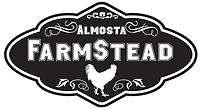





Almosta Farmstead
Guineas
We adore guineas...BUT...Are you ready for guineas?
Guineas are extremely hardy and great foragers! They are raised for eggs and meat. They discourage pests like snakes, eat bugs (especially ticks), and serve as an alarm system for your yard.
The average lifespan is 5-10 years.
Males reach an adult weight of 4 lbs and hens 3.5 lbs.
Shopping List
Brooder Supplies: Waterer, feeder, heat lamp reflector, heat bulb, pine shavings, paper towels, electrolytes and vitamins, thermometer, gro-gel, draft-free enclosure, coop or other safe housing, gamebird feed. For beginners, consider the chick starter kit which often includes everything you need to get started.
Suggested Reading
-
Guinea Fowl
-
Gardening with Guineas
-
Storey’s Guide to Raising Poultry
-
Guineafowl Past & Present
At the Post Office: Promptly pick up your package and get your chicks into the prepared brooder as soon as possible.
Live Guarantee: Look for the guarantee that properly cared for birds will be alive and well for 48 hours after they arrive at your post office. Check the full policy and claim form when ordering birds online.
Brooder Requirements: A half square foot per keet is recommended to start. The brooder must be sterile and draft-free. The brooder needs to be big enough so that the birds can move away from the heat source if needed.
Temperature: A thermometer is a baby keet’s best friend. Start your keets off at 99 degrees for the first three hours. Then 95 degrees the first week. Reduce by 5 degrees each week until they are fully feathered out, typically at 6 weeks and 70 degrees. Guineas are not as resilient to temperature fluctuations the first couple of weeks as baby chicks are. They are sensitive to temperature fluctuations, so be sure the temperature is stable.
Water: When you get your keets in the brooder, immediately dip their beaks in water to teach them how to drink. Guineas need to have access to clean drinking water at all times. Use a 1 gallon chick waterer for each 50 birds. Clean marbles in the dish will help prevent drowning. Warm water for the first few hours may be beneficial. Include vitamin or electrolyte powder in the water for an extra boost on the third day.
Feed: Food should be available at all times. Start your keets on a gamebird feed or turkey starter of 24-26% protein. Guineas require unmedicated feed. Weeks 5-8, provide them with 18-20% protein. Thereafter, they will do just fine on a 16% laying or breeder mash as a supplemental feed, with scratch feed mixed in. Guineas are great foragers so once they are allowed to free-range they will not need as much supplemental feed. This need will increase in the winter. For a treat and as a training add, offer guineas white millet.
Litter: The best option for bedding material is 2 inches of large size kiln dried pine shavings. Use paper towels above the shavings for the first few days. Do not use sawdust or cedar shavings. Bedding must be kept clean and dry.
Coop and Run Considerations: If keeping your guineas confined for any amount of time, they should have 2.5 to 4 square feet per bird inside and 10 square feet per bird in an outdoor run. They will tolerate extreme weather once they are fully feathered.
Homing your guineas: Once you put your guineas outside at 6-8 weeks of age, we recommend keeping them penned up for an additional 4-6 weeks. This way they will establish a home base. Guineas love to free-range and roost in trees where they are more protected from predators, but we recommend feeding them at a specific location at dusk each day to bring them back home. This will ensure their safety and will keep them from becoming wild and wandering off.
Keeping guineas with other birds: Guineas get along fine with other poultry. If free ranging, they will typically not associate with your other birds. If introducing new guineas to an existing flock, they should be separated initially. Adjustment time will be necessary while the guineas establish a pecking order.
Predators: Guineas are fast on their feet and are great fliers. They will evade most predators with ease. Common predators include hawks, owls, foxes, raccoons, opossums, coyote, etc. They are most vulnerable at night if roosting outside of a penned enclosure, or while they are sitting on a nest.
Safe Handling of Poultry: After handling poultry, wash your hands with soap and warm water. Do not let young children, elderly persons, or people with weak immune systems handle or touch live poultry. Do not snuggle or kiss your birds. You can get Salmonella from touching live fowl. Your birds can carry Salmonella and still appear healthy and clean. Regularly clean and sanitize your poultry equipment.
